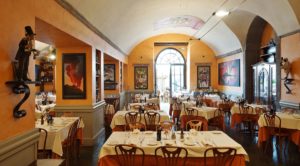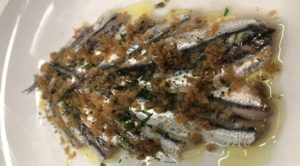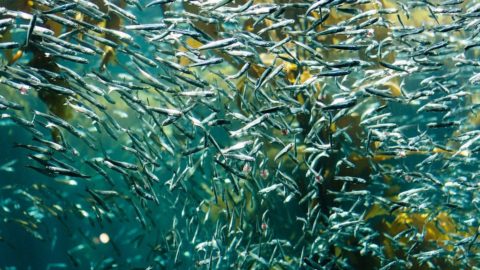There is no Christmas Eve without fish. But if you think this is a religious precept you are in a big mistake. In reality, the lean dinner preceding Christmas is a popular custom that is lost in time and which was codified by the Codex Iuris Canonici only in 1917. But he didn't have a long way to go because Pope Paul VI, who understood holiness, thought well of abolishing it in 1966 with the Apostolic Constitution Paenirtemini. So, since the Church has nothing to do with it, why do you eat fish on the 24th evening? Many have tried to answer this question but the recurring thesis is that our fathers, since we used to gather the whole family around the table to solemnly celebrate the birth of Christ, and the occasion called for numerous libations, had seen fit to prepare at the rich table on the 25th keeping a light stomach on the 24th in the evening with a healthy fish-based lunch.
Solved the problem of the theological explanation from the lean lunch let's now deal with the protagonist of the eve, the fish and above all the one that is fished and is tastier in this period, the blue fish so called commercially for its bluish back and silvery belly . Usually these are small fish at affordable prices but rich in omega 3 fats that we all know by now. This category includes sardines, herring, anchovies, mackerel, spatulas and horse mackerel and many others. Our seas offer a great abundance of these species and this determines their excellent quality/price ratio.
Blue fish in Italy is one great food and gastronomic resource. But be careful: the quality of the fish depends above all on its freshness, the considerable quantity of unsaturated fats present, on the one hand enriches our diet, on the other it determines a rapid deterioration. These fish products must be eaten very fresh and must be gutted as soon as possible. Over the centuries these characteristics have led to the development of various conservation techniques: salted, preserved in oil, smoking and drying, precisely to preserve the nutrients.
But what are the advantages that we can have by consuming oily fish? First of all, all the "blue" species are caught in the sea in the wild and this means that they feed in a completely autonomous and natural way, without feed. They are small in size so they are at the beginning of the food chain and they do not accumulate harmful substances such as mercuryas is the case with large fish. Nutritional values vary from species to species especially as regards fats: 2.6g/100g in anchovies and 11.1/100g in mackerel.
Just to describe one species, let's look at anchovies, the most loved in Italy: in 100g of raw food we find: 96 kcal, 16.8g of proteins, 2.6g of lipids and 1.5g of carbohydrates (CREA composition tables). Anchovies also contain: 278mg of potassium (improves blood pressure), 2.8g iron (immune defenses and transport of oxygen in cells), 148mg of calcium (for bones and teeth), 196mg of phosphorus (calcium absorption and cell regeneration) , 22mg magnesium (nervous system), 4.2micg zinc (skin) and vitamins A and B.
The peculiar aspect of oily fish is the presence of omega3 polyunsaturated fats (PUFA), essential fats for our body, which means that we need them but we are unable to synthesize them. In the omega 3 series the most important fatty acids are 2: eicosapentaenoic acid (EPA) and docosahexaenoic acid (DHA) of which oily fish is rich. The omega 6 fats are also part of the PUFA but are metabolically and functionally distinct from the omega 3, they have opposite physiological functions and their balance is important for the homeostasis of the organism.
Several studies confirm that man has evolved with a diet rich in omega3 and the omega6/omega3 ratio which was once close to 1:1, today this ratio is often 10:1 up to 20-25:1. The reason is that Western diets are too rich in omega 6 found in seed oils and meat and too low in fish. The LARN guidelines recommend reaching the 4:1 ratio to prevent a series of health risks.
Foods rich in omega 3 are good for our health: protect the cardiovascular system, they help maintain stable blood sugar, improve mood and concentration, they strengthen the immune system and the skin, improve the functionality of the retina and the gonads. Omega 3s are a lot important in pregnancy and in breastfeeding because they allow the correct development of the fetus and child.
Omega 3 they are good for the heart. Studies confirm that omega 3s decrease platelet aggregation, blood viscosity and fibrinogen with a protective effect against strokes and thrombus formation. In people with high cholesterol, omega 3 lower triglycerides and LDL and they can increase good cholesterol (HDL). Additionally, in some clinical trials omega 3 supplementation decreased the pain in patients with rheumatoid arthritis while in patients with psoriasis it decreased the toxicity of cyclosporine. Omega 3 have an immunomodulatory activity and EPA and DHA are the most powerful among the PUFAs.
They also have anti-inflammatory properties important in the management of autoimmune and inflammatory diseases characterized by high levels of interleukin 1, a proinflammatory cytokine. A number of clinical studies have demonstrated the benefits of dietary fish oil supplementation in diseases including: rheumatoid arthritis, Crohn's disease, ulcerative colitis, psoriasis, lupus erythematosus, multiple sclerosis and migraine which result in decreased disease activity and reduction of use of anti-inflammatory drugs.
Omega 3 they delay the degenerative processes of nerve cells and this is especially important in light of the failures of large pharmaceutical companies in Alzheimer's research. However, research continues to study nutraceuticals useful for the prevention of cognitive decline in the elderly because diseases such as Alzheimer's, Parkinson's and senile dementia greatly afflict both patients and their families.
Omega3 supplementation is beneficial in patients with mild cognitive impairment and perhaps it could help or at least delay its aggravation. In some studies, taking fish oil for 26 weeks improved perfusion in brain regions affected by cognitive impairment. Increasing the consumption of oily fish before the problems of old age appear could have long-term benefits.
Epidemiological studies demonstrate the positive effects of omega 3 against some tumors: in particular of the breast, colon and prostate with effect on cell proliferation and apoptosis (programmed cell death). These fats suppress angiogenesis and increase response to chemopreventive agents, reduce chemotherapy side effects and cachexia. Balancing omega6/omega3 in the diet is essential.
According to EFSA, to obtain the desired effects, the daily intake of EPA and DHA should be between 2 and 4g, while for the maintenance of normal cardiac function, 250mg per day is sufficient for healthy adults and children. Just to understand: in mackerel there are up to 5g of omega 3 in 100g of fish while in sardines almost 1.5g in 100g! Eating oily fish is good for you!
However, some precautions must be taken fish should be eaten fresh and well cooked to avoid anisakidosis. Anisakis is a parasite that could be found in the intestines of the fish and then move into the meat (for this reason the fish must be gutted immediately) and infect them with its larvae. The larvae then encyst in the wall of the digestive system and if they reach the intestine, they cause a severe granulomatous immune reaction a week or two after infection, with symptoms similar to those of Crohn's disease. This parasite is the main reason why the consumption of raw fish must be preceded by killing of the fish at -35 degrees and then frozen at -20 degrees for 24 hours or alternatively frozen at -20g for 7 days. As far as supplements are concerned, the best are those with IFOS certification and with the addition of vitamin E which naturally preserves the otherwise easily oxidizable omega 3s.
Fish has always been a very important and high quality biological resource for man. For thousands of years, coastal peoples have sustained themselves on fish. The "road of salt" has allowed trade, conservation of fish and its diffusion inland. In Ancient Greece blue fish was eaten daily, even the Falero anchovy was eaten raw while walking down the street, while in Ancient Rome the most used condiment was garum or liquamen, a sauce based on blue fish macerated in small tanks for several months with the addition of salt and aromatic herbs.
In the kitchen, blue fish is used in various ways and recipes with simple and quick cooking are the ones that enhance their flavor the most. Anchovies have very delicate but tasty flesh and are best eaten raw, macerated in lemon juice and vinegar and seasoned with oil and chilli pepper. Sardines are more rustic and lend themselves well to frying while mackerel is delicious in the oven or pan with cherry tomatoes, olives and capers.
Enjoy your meal!
 Restaurant The Basilica of Sorrento
Restaurant The Basilica of Sorrento
Via Sant'Antonino 28 80067 Sorrento (NA)
0818774790
www.ristorantelabasilica.com
info@ristorantelabasilica.com
A few steps from Piazza Tasso, behind the original XNUMXth century Basilica of Sant'Antonino, which houses the remains of Sant'Antonino, patron saint of Sorrento, stands the "La Basilica" restaurant. Paolo Esposito, affable and likeable patron, a storyteller who loves to chat with customers to open his book of memories of the Sorrento that was, destination of kings, princes, actors, captains of industry, opera artists, dancers, reigns supreme. Don't let yourself be enchanted by his predisposition for a constant smile and an all-Neapolitan engaging good-naturedness, in reality he never gets distracted from checking that his place works like a Swiss watch, where the customer must feel at the center of all attention, as if he were at home, but above all the quality must always be kept at a high level. A choice against the current for Paolo Esposito and pursued in the years to come with respect to a restaurant which, faced with the large tourist flows of the Sorrento peninsula, often aimed, except in rare cases, to satisfy tourist numbers rather than quality levels.
On the walls large paintings by Rosalinda Acampora, creative design from Sorrento, up the date, which re-proposes the gouaches of eighteenth-century travelers on the Grand Tour, with Vesuvius erupting by day and by night, reinterpreted in a metaphysical key, they also represent the hallmark of the cuisine of La Basilica : traditional Neapolitan cuisine with a touch of modernity. Because Paolo Esposito conceived this restaurant as a journey through the gastronomic history of Sorrento and Naples, and its territory. “We make the dishes of La Basilica – he says – with 70% of the fresh and genuine products of our beloved land, Campania. This is also thanks to our company, present on the hills of Sorrento, where we not only raise first choice meats, but we grow all kinds of vegetables. And this raw material of great richness then becomes the ingredient of each dish, always respecting its seasonality”.
The menu is therefore evidence of this gastronomic tour, from the ravioli (handmade) filled with fresh crab with zucchini sauce, to the blue Menaica anchovies (a very small production from the Gulf of Salerno) marinated on julienne strips of carrots and fennel; from fresh octopus from the Isola dei Galli (in front of Positano once owned by Rudolph Nurejev), steamed potatoes with oil and lemon sauce to flag fish Parmigiana with aubergines and Sorrento mozzarella. Or even black fettuccine (handmade) with fresh fish squid and piennolo cherry tomatoes (grown on the slopes of Vesuvius along the sciara of the 1943 eruption); Handmade black and white tagliolini with fresh crab and Agerola cherry tomatoes (on the Lattari mountains) with red prawns from Crapolla, a fjord near Marina del Cantone, with mixed grilled Gulf fish (swordfish, squid, prawns and fillet of fish). And obviously a journey into the Neapolitan gastronomy culture could not pass through one of its symbolic products, the Pizza Napoletana, a Unesco heritage which is declined in different versions.
The Wine List is the natural continuation of the flavors and dishes, with the exclusive selection of wines aged in the cellar which boasts well over 1300 labels, among which a selection of the best Campania production stands out, all the famous national labels and the cellars emerging. An important section is dedicated not only to the great vintages of the most celebrated wines, but also to magnums.
 Method
Method
Arregnate anchovies (dialectal word that stands for "sprinkled with oregano" as explained by Carlo Iandolo's Neapolitan Semantic-Etymological Dictionary, a poor recipe from the Neapolitan coastal tradition)
Ingredients for 4 people:
800 gr of anchovies
150 gr of breadcrumbs
1 clove of garlic
a few leaves of Mediterranean mint
extra virgin olive oil to taste
a handful of oregano
2 tablespoons of vinegar or lemon juice
Salt and freshly ground pepper
Procedure:
Remove the bones from the anchovies
Rinse them well
Arrange them in layers in a pan
Salt and pepper
Sprinkle with the breadcrumbs, minced garlic and mint, as well as the oregano
Add the evo oil
Finally a splash of vinegar or lemon juice
Put them in the oven at 180°C for about 10 minutes
Serve piping hot





